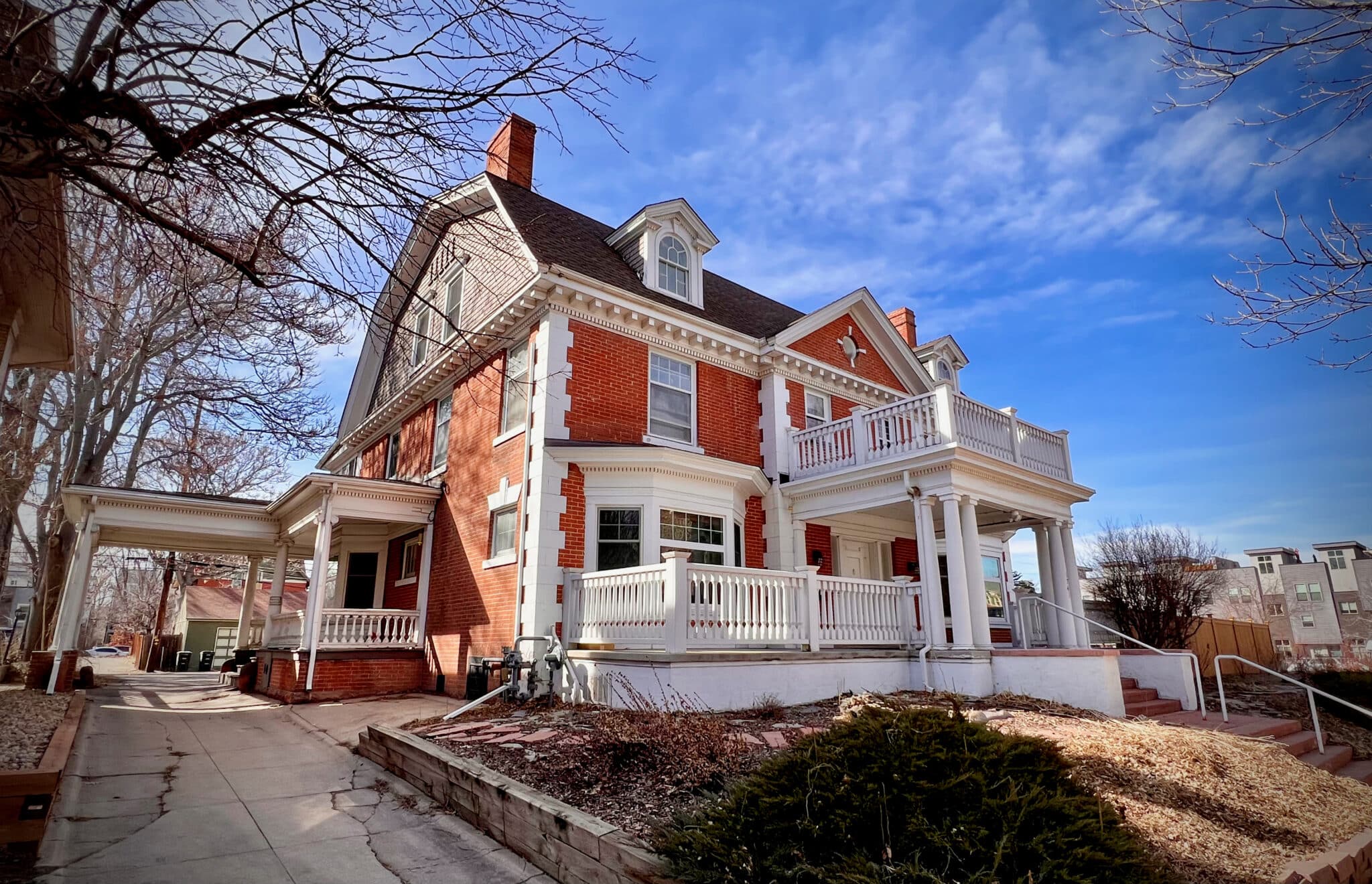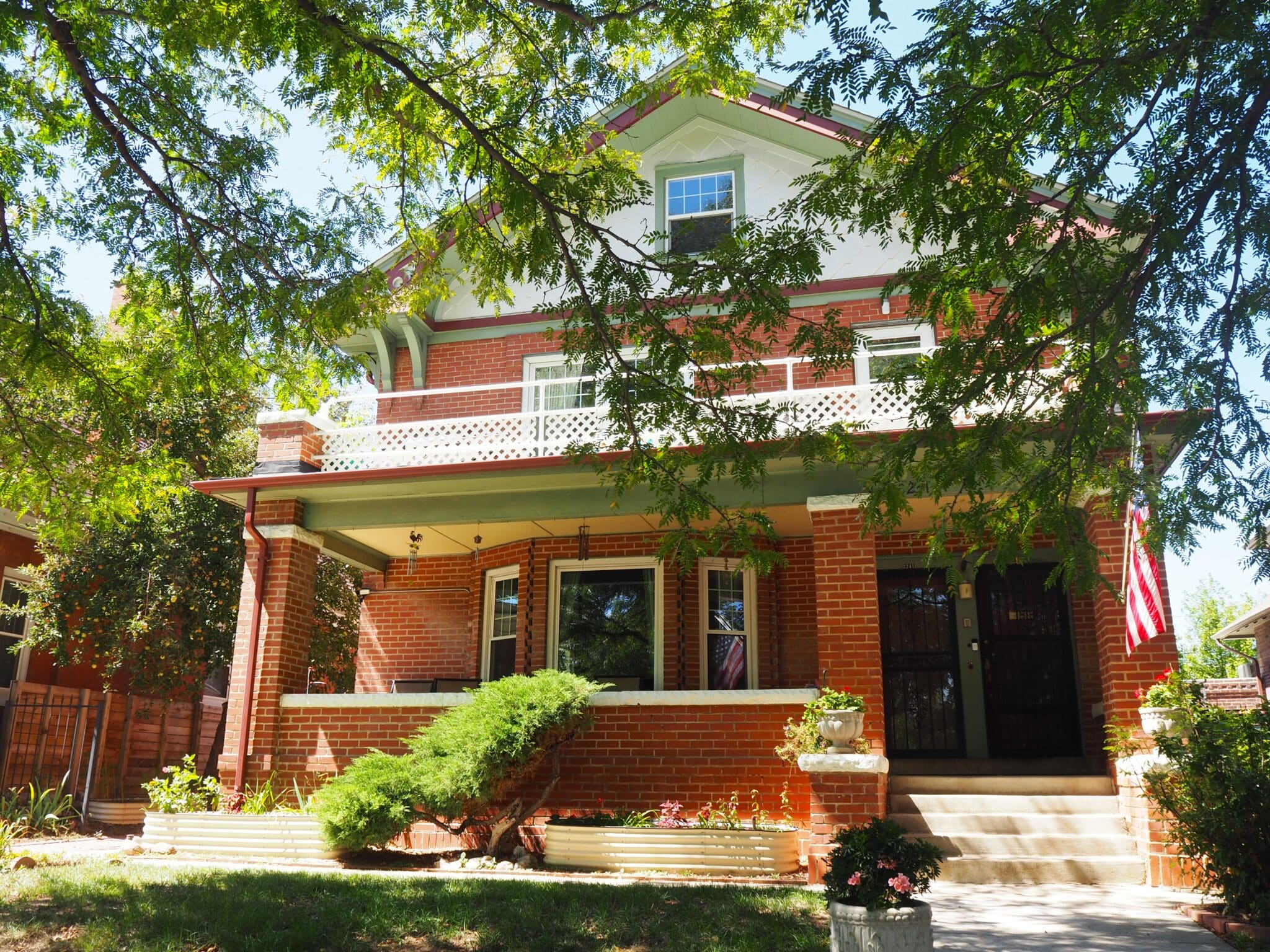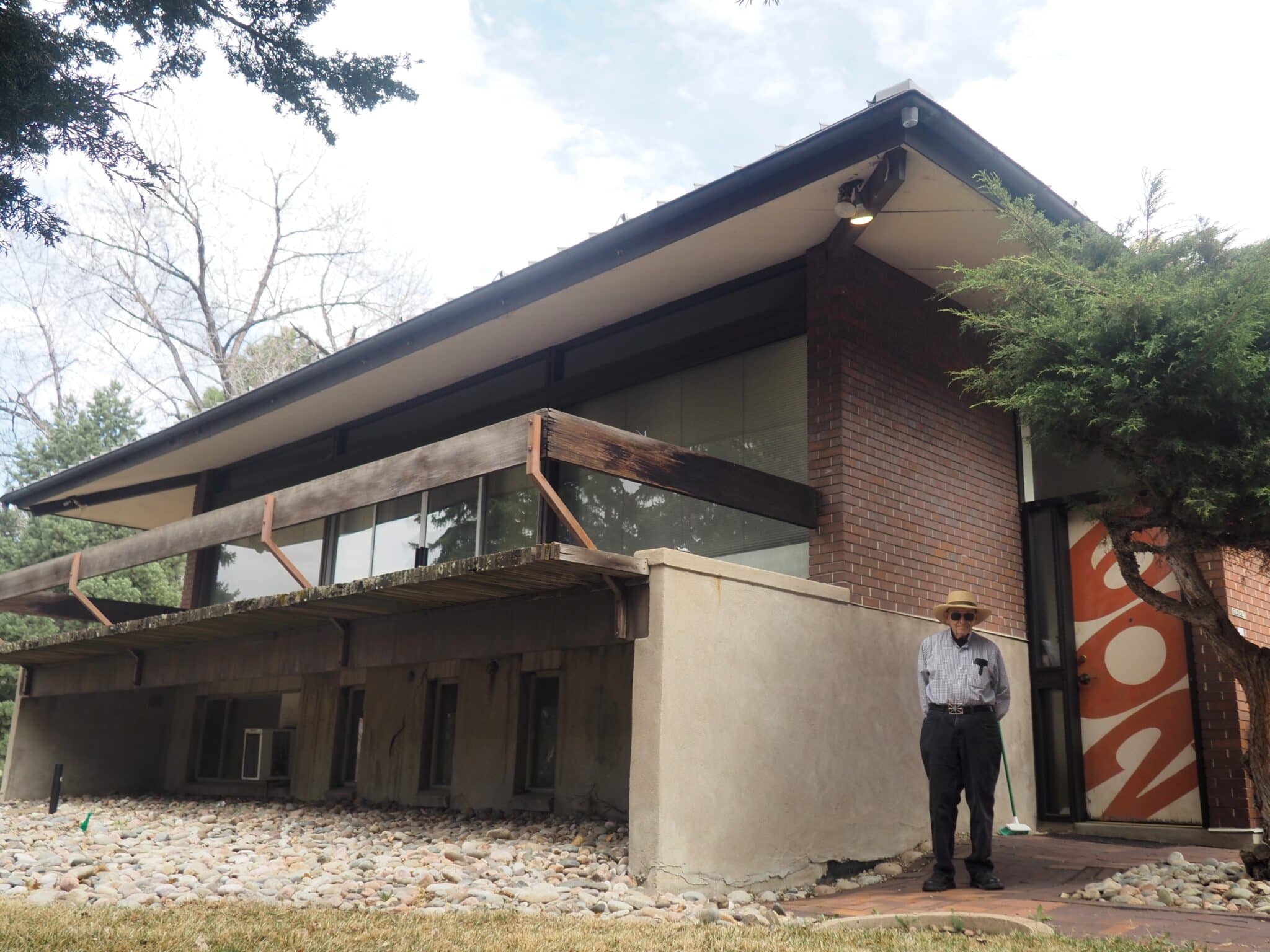
The home at 1741 Gaylord St. dates to the early 1900s. (Courtesy Historic Denver)
For five structures and one city park in Denver, 2023 was a landmark year.
That’s because the Denver City Council awarded them landmark status, which recognizes properties of historical, architectural, geographical and cultural importance to the city. The status also effectively prevents a building from being demolished.
A former church in Cole, a late civil rights attorney’s home across from City Park and a structure a developer wanted to demolish were among those that made the cut.
Here’s a breakdown of each property that received landmark status this year:
1741 N. Gaylord St.
Most buildings named Denver landmarks are done so at the request of the owner.
Not so for 1741 Gaylord St., a mansion in the Dutch Colonial Revival style that dates to 1902.
The home originally was constructed for Edward Holmes Hurlbut, a local grocer, and was later owned by James and Edith Burger. James was a banker and state senator for four years, while Edith helped start Children’s Hospital Colorado, according to the applicants.
The building is owned by Denver developer Mike Mathieson, who wanted to demolish it and build apartments. But neighbors lobbied city leaders to save it from the wrecking ball by giving it landmark status. Mathieson subsequently filed a lawsuit, which is still pending.
It was only the second owner-opposed landmark application approved by council.
2241-2243 York St.

The home at 2241-2243 York St. in Denver is now a city landmark. (BusinessDen file)
The former home and law office of civil rights attorney Irving P. Andrews was given landmark status via a unanimous vote from the City Council in August.
Built in 1914, the home was Andrews’ from the 1970s until his passing in 1998. Still owned by his family, the house is a duplex constructed in the Vernacular Queen Anne style, per the property’s landmark application.
Born in Denver in 1925 and raised in Pueblo, Andrews served in the Navy during WWII and graduated from the University of Denver’s law school in 1950, per his biography on the Denver Public Library’s website.
The lawyer served on the legal team that brought Brown vs. the Board of Education, which outlawed racial segregation in public schools, before the Supreme Court. Andrews also started the first integrated law practice in Colorado, served as president of the NAACP for Colorado and Wyoming, and marched with Martin Luther King Jr., the application said.
1618 E. 38th Ave.
Constructed in 1888 to serve the Swedish immigrant community in Cole, this church on the corner of Franklin and 38th was given landmark status by the council in February.
Lutheranism used to be the state religion of Sweden and today remains the nation’s most practiced faith. The first Swedes came to Denver to work the railroads that would give birth to the Cole neighborhood. The building’s simple design is both a testament to its working-class roots and Lutheran architectural preferences, which often eschews typical Christian iconography, per the property’s landmark application.
The structure was last used as a Lutheran church in the 1950s. Other Christian groups would hold services there until 1980, when it was sold and converted to its current use as a private residence.
618 S. Monroe Way
It would make sense that the more expensive a property would be to build, the more unique and striking it would be. That’s not the case with this midcentury, A-frame home.
Built by Denver couple Bill and Priscilla Muchow to be their private residence, they told The Denver Post in 1956 that “modern homes have been compressed by high costs, but I feel they can still have an air of spaciousness … despite a tight budget.”
The home was revered for its Modernism, which won it a number of awards both in and out of the city. The council designated it as a landmark in April.
602 S. Harrison Lane

Alan Gass stands by his home in Denver’s Belcaro neighborhood earlier this year. (BusinessDen file)
This application was submitted by the home’s designer and current owner, Alan Golin Gass, and the council unanimously approved it in May.
“I’m delighted because it assures me that this is at least one of my buildings that won’t be demolished,” the 92-year-old Gass told BusinessDen upon passage.
Gass, a fourth-generation Denverite, started his architecture career with I.M. Pei. He has worked for 12 architecture firms and founded his own firm, Alan Golin Gass Architecture, now known as AGGA, in 1960.
Gass built his home in the Belcaro neighborhood in 1961. It features a striking design feature: a giant square-shaped skylight in the center of the roof. When the building was completed, The Denver Post wrote that the house “almost caused traffic jams” from those who drove by and slowed down to get a better look.
La Raza Park Historic Cultural District
Not a single building, but rather an entire city block on the edge of Sunnyside and the Highlands, La Raza Park was the first playground the city owned.
First constructed in 1906, it was frequented by Denver’s nascent Italian-American population, before becoming a gathering place for the Chicano Movement, which campaigned for equal rights for Latinos in the city. In that same vein, it also served as an important area for Hispanic-American culture in religion, the arts and community, according to the landmark application.
“La Raza,” which translates to “the race,” is an expression used to represent the blending of Spanish and indigenous-American ethnicities and culture. The council approved it in June as Denver’s third historic cultural district, joining the Five Points Historic Cultural District and La Alma Lincoln Park Historic Cultural District.
Historic cultural districts differ from traditional historic districts in that the former is preserved principally on the basis of its cultural significance, while the latter is more concerned with the architecture and design of the space.

The home at 1741 Gaylord St. dates to the early 1900s. (Courtesy Historic Denver)
For five structures and one city park in Denver, 2023 was a landmark year.
That’s because the Denver City Council awarded them landmark status, which recognizes properties of historical, architectural, geographical and cultural importance to the city. The status also effectively prevents a building from being demolished.
A former church in Cole, a late civil rights attorney’s home across from City Park and a structure a developer wanted to demolish were among those that made the cut.
Here’s a breakdown of each property that received landmark status this year:
1741 N. Gaylord St.
Most buildings named Denver landmarks are done so at the request of the owner.
Not so for 1741 Gaylord St., a mansion in the Dutch Colonial Revival style that dates to 1902.
The home originally was constructed for Edward Holmes Hurlbut, a local grocer, and was later owned by James and Edith Burger. James was a banker and state senator for four years, while Edith helped start Children’s Hospital Colorado, according to the applicants.
The building is owned by Denver developer Mike Mathieson, who wanted to demolish it and build apartments. But neighbors lobbied city leaders to save it from the wrecking ball by giving it landmark status. Mathieson subsequently filed a lawsuit, which is still pending.
It was only the second owner-opposed landmark application approved by council.
2241-2243 York St.

The home at 2241-2243 York St. in Denver is now a city landmark. (BusinessDen file)
The former home and law office of civil rights attorney Irving P. Andrews was given landmark status via a unanimous vote from the City Council in August.
Built in 1914, the home was Andrews’ from the 1970s until his passing in 1998. Still owned by his family, the house is a duplex constructed in the Vernacular Queen Anne style, per the property’s landmark application.
Born in Denver in 1925 and raised in Pueblo, Andrews served in the Navy during WWII and graduated from the University of Denver’s law school in 1950, per his biography on the Denver Public Library’s website.
The lawyer served on the legal team that brought Brown vs. the Board of Education, which outlawed racial segregation in public schools, before the Supreme Court. Andrews also started the first integrated law practice in Colorado, served as president of the NAACP for Colorado and Wyoming, and marched with Martin Luther King Jr., the application said.
1618 E. 38th Ave.
Constructed in 1888 to serve the Swedish immigrant community in Cole, this church on the corner of Franklin and 38th was given landmark status by the council in February.
Lutheranism used to be the state religion of Sweden and today remains the nation’s most practiced faith. The first Swedes came to Denver to work the railroads that would give birth to the Cole neighborhood. The building’s simple design is both a testament to its working-class roots and Lutheran architectural preferences, which often eschews typical Christian iconography, per the property’s landmark application.
The structure was last used as a Lutheran church in the 1950s. Other Christian groups would hold services there until 1980, when it was sold and converted to its current use as a private residence.
618 S. Monroe Way
It would make sense that the more expensive a property would be to build, the more unique and striking it would be. That’s not the case with this midcentury, A-frame home.
Built by Denver couple Bill and Priscilla Muchow to be their private residence, they told The Denver Post in 1956 that “modern homes have been compressed by high costs, but I feel they can still have an air of spaciousness … despite a tight budget.”
The home was revered for its Modernism, which won it a number of awards both in and out of the city. The council designated it as a landmark in April.
602 S. Harrison Lane

Alan Gass stands by his home in Denver’s Belcaro neighborhood earlier this year. (BusinessDen file)
This application was submitted by the home’s designer and current owner, Alan Golin Gass, and the council unanimously approved it in May.
“I’m delighted because it assures me that this is at least one of my buildings that won’t be demolished,” the 92-year-old Gass told BusinessDen upon passage.
Gass, a fourth-generation Denverite, started his architecture career with I.M. Pei. He has worked for 12 architecture firms and founded his own firm, Alan Golin Gass Architecture, now known as AGGA, in 1960.
Gass built his home in the Belcaro neighborhood in 1961. It features a striking design feature: a giant square-shaped skylight in the center of the roof. When the building was completed, The Denver Post wrote that the house “almost caused traffic jams” from those who drove by and slowed down to get a better look.
La Raza Park Historic Cultural District
Not a single building, but rather an entire city block on the edge of Sunnyside and the Highlands, La Raza Park was the first playground the city owned.
First constructed in 1906, it was frequented by Denver’s nascent Italian-American population, before becoming a gathering place for the Chicano Movement, which campaigned for equal rights for Latinos in the city. In that same vein, it also served as an important area for Hispanic-American culture in religion, the arts and community, according to the landmark application.
“La Raza,” which translates to “the race,” is an expression used to represent the blending of Spanish and indigenous-American ethnicities and culture. The council approved it in June as Denver’s third historic cultural district, joining the Five Points Historic Cultural District and La Alma Lincoln Park Historic Cultural District.
Historic cultural districts differ from traditional historic districts in that the former is preserved principally on the basis of its cultural significance, while the latter is more concerned with the architecture and design of the space.
